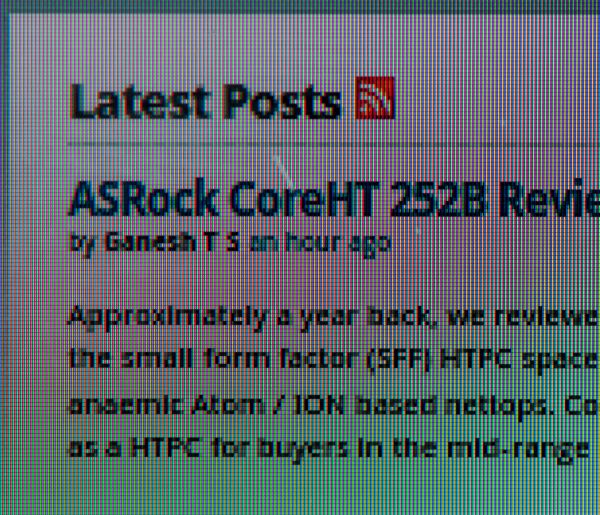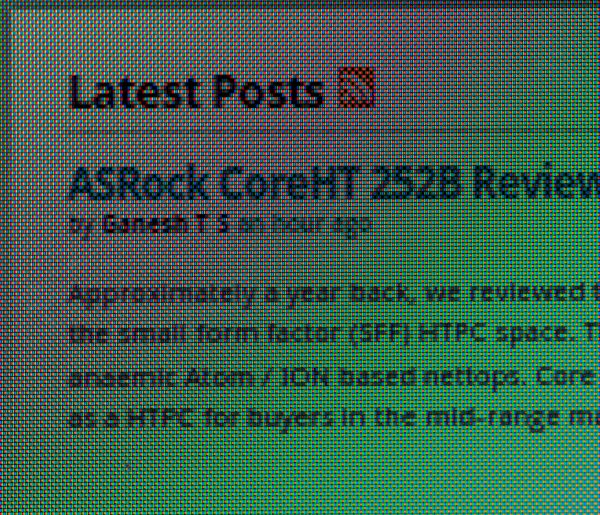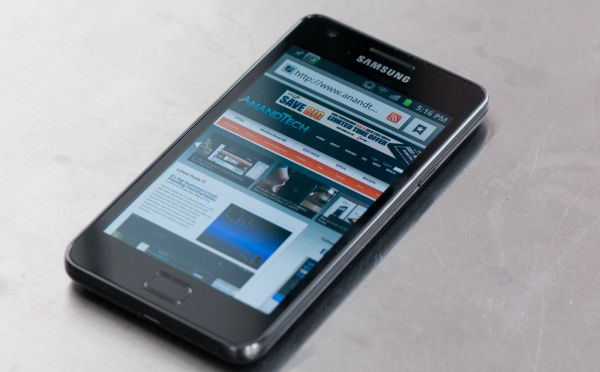Samsung Galaxy S 2 (International) Review - The Best, Redefined
by Brian Klug & Anand Lal Shimpi on September 11, 2011 11:06 AM EST- Posted in
- Smartphones
- Samsung
- Galaxy S II
- Exynos
- Mobile
Display
One of the highlights of SGS2 is its 4.3“ SAMOLED+ display, which we’ve seen before on phones like the Droid Charge, and a 4.5” version of on the Samsung Infuse 4G. Though the panel is the same as what we’ve seen in the past, the controller and software are different.
As a quick refresher, Samsung has now passed through three variants of AMOLED. The first was straight up AMOLED which we saw on phones like the Nexus One and Incredible in a 3.7“ WVGA format with RGBG PenTile. The next was Super AMOLED, which was 4.0” WVGA with PenTile and adorned Galaxy S. The main improvements with Super were integration of the digitizer with top glass and use of optically transparent adhesive to reduce air gaps and subsequent fresnel reflections that add glare and reduce transmissivity. The net effect of that was improved outdoor readability and potentially some power savings from losing less light to back reflections.


Left: Super AMOLED Plus, Right: Super AMOLED
So now we’re up to Super AMOLED Plus (SAMOLED+), so what does this add? Well first, size is now 4.3“ or 4.5” (depending on what tickled some carrier’s fancy), and resolution is still WVGA (800x480), but the big change is that PenTile RGBG is gone. In its place is a standard RGB stripe. I’ve been rather critical of RGBG PenTile in the past purely because it emulated higher effective resolutions by using fewer subpixels (2 per logical pixel) and as a result had a characteristic grain in some circumstances. On AMOLED especially it wound up being distracting more than it was novel, and on 4" displays, it seemed that subpixels were visible with the naked eye and average visual acuity. Furthermore there were some issues with an offset pattern like RGBG and the UI direction Android was taking. Single pixel wide UI elements, some text, and solid primary colors were the main culprits where RGBG could, without considerable scrutiny, look characteristically grainy.
So why is it gone now? The big reason is probably because a corresponding move to a larger panel increases the size of those subpixels, and no doubt 4.3“ WVGA with PenTile would look even more grainy despite having the same ”effective“ resolution. Four inches was pushing it for a grid that started life at 3.7”, and 4.3“ probably was a step too far. In addition, subpixels are also correspondingly larger in the 4.3” RGB stripe (and the process mature enough now) that certain color subpixels being more prone to failure than others (and this needing to be sized appropriately) should no longer be a concern. Samsung also claims that power drain has been reduced in SAMOLED+ by almost 20% from the previous generation, no doubt partially thanks to fabrication maturity and changes made that come with better understanding of the process.
The same benefits apply with SAMOLED+ as the previous generations though - absolutely black blacks due to the subpixels not emitting any light in the off state, and potentially super vibrant colors (if calibrated properly). Unfortunately the few issues we saw with SAMOLED+ on other phones continues here as well - white point that varies with brightness level, a chance of overheating, and a bit of lingering sharpening.
Let’s start with the first one, which a lot of users have dubbed ‘yellowing’. For a while now we’ve been gathering white point data at various brightness levels. Obviously we did the same thing with SGS2.

I’ve measured brightness (full-screen white and black) and white point at six brightness levels on the SGS2. Before I measured the SGS2, I noted that subjectively there’s the most visible change in color temperature after you dip below the 50% brightness mark. To that extent, I took more measurements below that halfway point. I also tossed in the Samsung Infuse 4G (which we received but didn’t formally review) which has a 4.5" SAMOLED+ display that no doubt is identical to what’s headed to the Sprint and T-Mobile SGS2 variants, though with a different display controller. I also tossed in the Samsung Galaxy S 4G as a SAMOLED data point, and the Nexus One as an AMOLED data point, just so you can see how things have changed over the now 3 generations of AMOLED panels Samsung has shipped.
The data bears out the effect that numerous subjective parties have noticed - SGS2’s display temperature gets warmer at lower brightnesses, and varies between 7328K at 0% brightness and 8600K at 100% brightness. It’s enough of a delta in white point to be unfortunately very visible to the naked eye. There’s also an interestingly large amount of variance between the three SAMOLED+ phones we’ve measured, though the same shape curve is just translated around for the Infuse, the Charge appears to be very blue everywhere. Bear in mind again that the SGS2 uses a different display controller than the previous generation of devices.











132 Comments
View All Comments
tipoo - Sunday, September 11, 2011 - link
The iPhone 4 always scores near the bottom of the 2.0 test since its native resolution is so high, but I'd be interested to know how it does with the resolution independent 2.1 test?B3an - Sunday, September 11, 2011 - link
...but the iPhone 4 is already in the 2.1 tests which are all run at 1280x720 so it's equal on every phone... and unsurprisingly it's the worst performer.Lucian Armasu - Sunday, September 11, 2011 - link
The iPhone 4 has a GPU that is one generation older than the one in the first Galaxy S phone. So that's the main reason why it performs the worst in all these GPU tests.LostViking - Saturday, September 17, 2011 - link
You can do the math already.If you calculate the pixel ratio (width * height) between the iPhone and the others you can correct the numbers.
3lackdeath - Sunday, September 11, 2011 - link
When are you guys going to start adding WP7 to the Comparisons list WP7 is soooo lacking in your reviews.It has been out for a while now you know, a long long time did i say long?.
shamalh108 - Sunday, September 11, 2011 - link
Hi Brian.. first off thanks for the great review..its quite honestly the best I've read on the SGS2..As an SGS2 user i need to just testify to my experience of the AOS bug..
This bug or its effects aren't actually experienced by me while the phone is actually in use, but actually results in a dramatic use of battery when in suspend.. it is intermittent so it won't occur all the time but over the last month I've been able to identify it using battery monitor pro.
what i find is that in the morning when unplugged i can put my edge data on and then leave the phone in standby for up to two hours and see no drain... if i then proceed to use the phone for about 20min and note the battery percentage , i then lock the phone and leave it in standby again with edge data enabled and push email... after closing all tasks but the battery percentage will drop by up to 10% in those two hours while battery monitor pro reports an estimate usage of 100+ mah ..compared to the same running conditions it was in when just unplugged and consumed almost no power. this isn't always the case though sometimes the phone will only drop 2% or less per hour with the battery monitor pro reporting usage of 25~35 mah ... As you can see this bug actually affects standby time more than nonstop usage and that is probably why the benchmarks havent been affected.. also im not sure if its normal but when the phone is experiencing the high usage and i look at the process cpu usage the events and suspend process are consuming around 15~20% cpu... this checked immediately after unlocking the phone using watchdog task manager pro.
while i understand all the measurements are estimates .. i really feel the effects of this as with the same usage i can't be certain if ill get the 14hours battery life i need or 10.. what is the normal power consumption for an android phone in suspend as I've noticed my brothers HTC desire consistently consumes 10~15mah in standby with a similar set up..
again thanks for the great review..
my international SGS2 is running stock with no root , XXKF3 .
willstay - Sunday, September 11, 2011 - link
I have been using SGS2 for two months now and this is my 3rd Android. In the past, I always flashed closest to stock ROM, now after 2 months, I think google should consider touchWiz kindof UI as default. It is really minimalistic with just few tiny bit feature that makes it way better than stock - folders and page scrolling where I can put important apps in page 1, system apps in page 2 and so on.One consistent touchWiz feature to swipe contacts left for message and right for call is a must have.
I must be having over sensitive eye that comfortable brightness level I use during day (indoor) is zero and for evening and night, I am using app called "Screen Filter" to make it dimmer. (I know this is only me - for my laptop I had to hack drivers to make it dimmer than allowed normally).
When idle, processor goes back to 200 MHz and normally with wifi off, cellular net off, SGS2 lives through the night depleting only 1% of the battery. When I only use it for phone and sms, I get two days. Most of the time when I have access to desktop, I turn off wifi and push mail. My usual battery indicator runs as follows - fully charged before going to sleep - 99% when I wake up - I turn wifi and push mail on and by the time I move out to office it is 97% - wifi off in office but sometimes on when I move out of my desk to run SIP client and get my desk extension routed to phone and by lunch time it is 90% - push mail on and cellular net on during lunch time 86% - when I reach home it is from 80 to 75% - that is when my phone gets highest load of games, browsing, wifi, pushmail until I plug for charing around 11 pm and before I plug in it is usally 30%. For comparison, the lowly Nokia 1280 I am using for backup ran for 15 days in single charge and there was still 1/5 bar left in it.
"light weight seems to imply a certain level of cheapness" - people will soon start to understand weight has no correlation with quality and when devices grow bigger and bigger, they will appreciate lighter weight design.
As for me, this is my first Samsung and I am impressed!! Unfortunagely SGS2 has short life it seems - I am so impressed with this light weight, thinness, SAMOLED+, touchWiz that I am getting SG-Note at whatever cost when it comes out :)
shamalh108 - Sunday, September 11, 2011 - link
hey willstay.. wow ! please help me , how are you getting such astonishing battery life ? what Rom are you on ? is your phone used at all during the day ? i simply can not get that kinda standby consumption between my few use periods during the day.. i love my phone and right now its just the battery life that's frustrating me.. why are the reports so varied .. any info you have would be welcome :)ph00ny - Sunday, September 11, 2011 - link
I'm also getting a full day of usage like the user above. I ran stock rom forever until i ventured over to the some of the newer custom roms and i'm getting slightly less battery life with the newest sensation 1.6 rom (2.3.4) compared to stock and cognition 1.07.willstay - Sunday, September 11, 2011 - link
I am using default ROM but flashed kernel for rooting. I guess it must be rouse app. I've found Location And Security -> Use Wireless Networks eats up around 7% of battery through night (which otherwise is only 1%). Sometimes service called MediaService (after I've played songs through Btooth) eats up around 25% through sleep hours. Once I used very nice network bandwidth monitoring app to find individual data usage, it was sipping 25% during sleep hours (I install this app only when I need it). Pushmail on low signal cellular network eats battery like hell - my phone gets warm at the back. Interestingly, always-on low light digital clock of app NoLED eats only 20% through night. For most of the bug related drainage, flushing RAM helps.If I were you, I would temporarily uninstall few apps at a time to find the culprit. You may be able to short list possible apps through battery usage tool of the phone too.